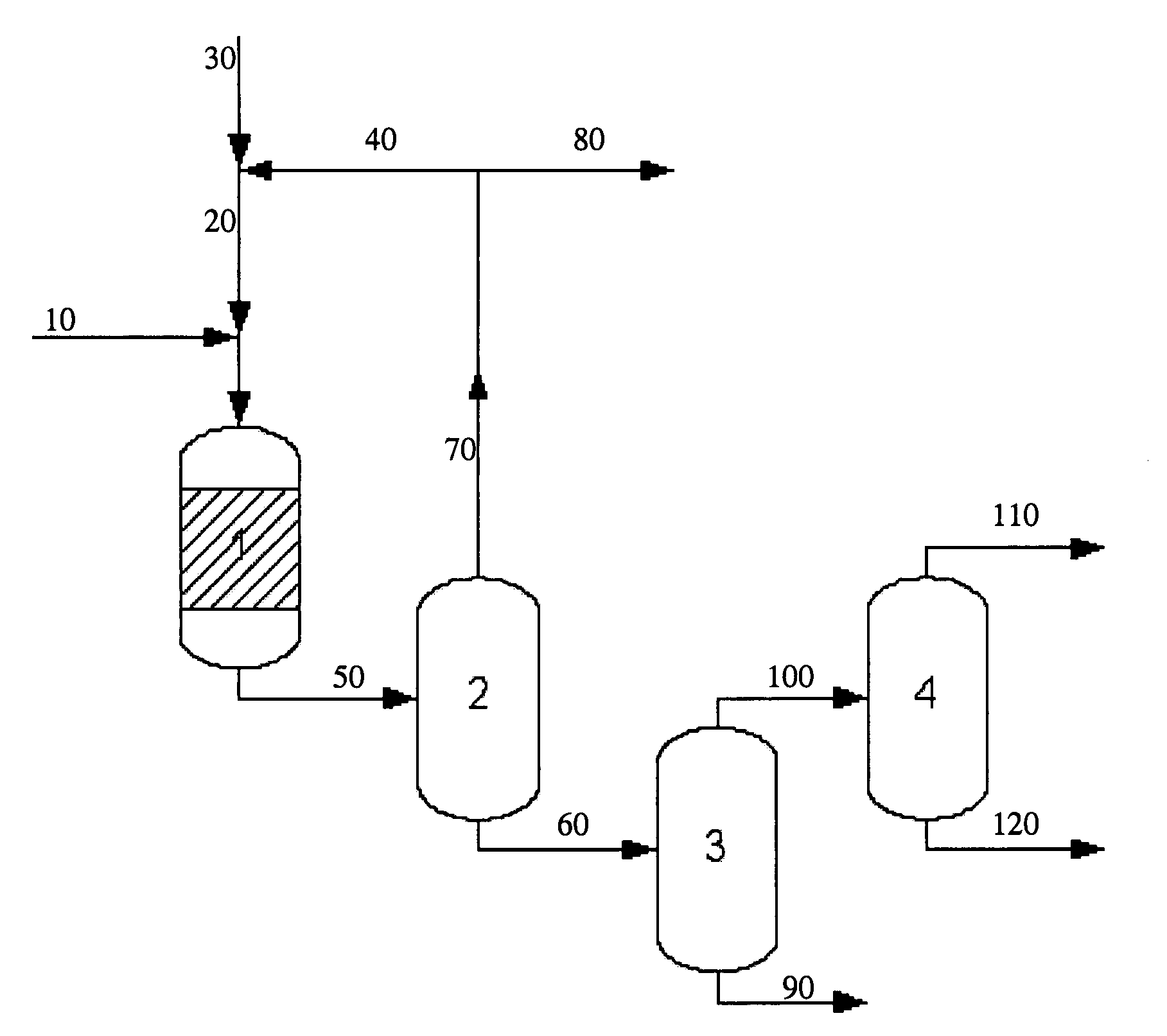Production of diesel fuel from vegetable and animal oils
a technology of vegetable and animal oil and diesel fuel, which is applied in the direction of fuels, hydrocarbon oil treatment products, fuels, etc., can solve the problems of adversely affecting the environment, limited crude oil supply, and limited use of crude oil as a fuel sour
- Summary
- Abstract
- Description
- Claims
- Application Information
AI Technical Summary
Benefits of technology
Problems solved by technology
Method used
Image
Examples
example 2
Production of Diesel from Soybean Oil
[0038] Refined soybean oil was fed to a fixed-bed reactor packed with a granulated 1.5 wt % Pt / SAPO-11 catalyst operated at an LHSV of 1.0 h−1, 370° C., 40 atm, and an H2 / oil ratio of 1000 NL / L. The run was carried out for >250 hours. The gas phase contained, besides hydrogen, carbon dioxide and propane. The total liquid product was separated into two phases, water and an organic phase. The organic phase was further separated into light (<150° C.) and heavy (diesel product) fractions. The diesel product was analyzed according to ASTM methods. The results can be found in Table 4.
TABLE 4Example 2OilSoybeanTemperature370°C.CatalystGranulated1.5 wt % Pt / SAPO-11LHSV, hr−11.0Pressure, atm40H2 / oil ratio, NL / L1000Distillation TemperatureASTM D86IBP223.2°C.10%284.1°C.50%296.5°C.90%337.7°C.95%367.9°C.Full Boiling Point374.0°C.Up to 250° C.1.2%Up to 350° C.92.3%Cold Filter Plugging Point (CFPP)IP 309−4° C. (+ / −2.5)Lubricity (HFRR)ISO 12156 / 1188μmCetane I...
example 3
Production of Diesel from Soybean Oil
[0040] Refined soybean oil was fed to a fixed-bed reactor packed with a granulated 1 wt % Pt / SAPO-11 catalyst operated at an LHSV of 1.0 h−1, 375-390° C., 30 atm, and an H2 / oil ratio of 1200 NL / L. The total liquid products were each separated into two phases, water and an organic phase. The organic phases were further separated into light (1 to C4 hydrocarbons. The diesel products were analyzed according to ASTM methods and the composition of the diesel products were measured by GC-MS and confirmed by NMR. The results can be found in Table 5.
TABLE 5Example 3AExample 3BExample 3COilSoybeanSoybeanSoybeanTemperature375°C.385°C.390°C.CatalystGranulatedGranulatedGranulated1 wt % Pt / 1 wt % Pt / 1 wt % Pt / SAPO-11SAPO-11SAPO-11LHSV, hr−11.01.01.0Pressure, atm303030H2 / oil ratio, NL / L120012001200Distillation TemperatureASTM D86IBP208.1°C.190.3°C.186.8°C.10%291.3°C.272.5°C.266.1°C.50%294.6°C.293.2°C.298.1°C.90%326.7°C.332.9°C.360.3°C.Up to 250° C.1.9%3.1%4...
example 5
Production of Diesel from Soybean Oil
[0045] Refined soybean oil was fed to a fixed-bed reactor packed with a granulated 1 wt % Pt / SAPO-11 catalyst operated at an LHSV of 1.0 h−1, 375-390° C., and an H2 / oil ratio of 1200 NL / L. The pressure was 30 atm in Example 5A and 20 atm in Example 5B. The total liquid products were each separated into two phases, water and an organic phase. The organic phases were further separated into light (1 to C4 hydrocarbons. The diesel products were analyzed according to ASTM methods and the composition of the diesel products were measured by GC-MS and confirmed by NMR. The results can be found in Table 7.
TABLE 7Example 5AExample 5BOilSoybeanSoybeanTemperature380°C.385°C.CatalystGranulatedGranulated1 wt % Pt / 1 wt % Pt / SAPO-11SAPO-11LHSV, hr−11.01.0Pressure, atm3020H2 / oil ratio, NL / L12001200Distillation TemperatureASTM D86IBP192.0°C.228.0°C.10%272.5°C.280.2°C.50%292.0°C.293.7°C.90%322.1°C.321.0°C.Up to 250° C.2.6%1.1%Up to 350° C.92.9%92.7%Cold Filter P...
PUM
| Property | Measurement | Unit |
|---|---|---|
| Fraction | aaaaa | aaaaa |
| Fraction | aaaaa | aaaaa |
| Pressure | aaaaa | aaaaa |
Abstract
Description
Claims
Application Information
 Login to View More
Login to View More - R&D
- Intellectual Property
- Life Sciences
- Materials
- Tech Scout
- Unparalleled Data Quality
- Higher Quality Content
- 60% Fewer Hallucinations
Browse by: Latest US Patents, China's latest patents, Technical Efficacy Thesaurus, Application Domain, Technology Topic, Popular Technical Reports.
© 2025 PatSnap. All rights reserved.Legal|Privacy policy|Modern Slavery Act Transparency Statement|Sitemap|About US| Contact US: help@patsnap.com


